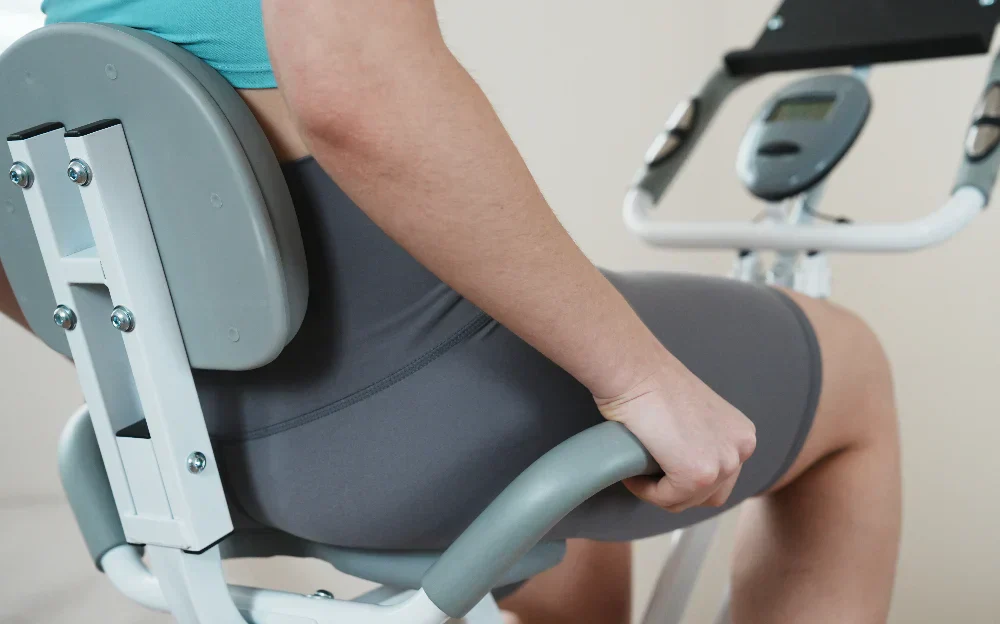The exercise bike and elliptical trainer are both great for low-impact workouts. But if you’re deciding which one to buy to support your hip health, which is the better choice?
In this article, we will walk you through the pros and cons of these two machines for hip health to help you choose the right hip exercise machine. We’ll also introduce the Tousains foldable exercise bike for small apartments. Let’s dive in right now!
Understanding Hip Movement in Cardio Exercises
The hips connect your legs with your torso. They play a vital role in your daily life, including supporting your body weight, maintaining balance, and moving your upper legs. [1]
However, modern lifestyles, especially prolonged sitting or physical inactivity can lead to passive hip extension. [2] Playing Sports, running, overuse, or falling can lead to hip injuries too. [3]
That’s where low-impact cardio comes in—offering a way to stay active and build strength without putting excess stress on your hips.
Elliptical for Hips
The elliptical simulates a running or walking motion but without the joint-pounding impact. Whether you are pedaling forward or backward, your hips move naturally in tandem with your legs and core.
Pros of Using the Elliptical:
Low Impact on Joints: The elliptical machine is one of the most joint-friendly machines. Is the elliptical good for hip pain? Yes, the Arthritis Foundation recommends the elliptical machine for individuals with knee and hip arthritis, as it enhances cardiovascular health while placing less stress on the joints.
Full Range of Motion: The elliptical enables your hips to move through a wider, more natural range of motion compared to cycling. It activates both hip flexors and extensors, promoting joint mobility and muscular balance.

Engages More Muscle Groups: Compared to cycling, using an elliptical engages more muscles, including arms, glutes, quads, and core. If you are looking for a piece of exercise equipment for your hips and thighs, it is the right choice.
Customizable Resistance and Incline: Users can adjust the resistance or incline levels to target different muscle groups, including glutes and hips. Some models are even equipped with adjustable stride length, making it easier to use.
Cons:
- May require good balance and coordination
- Might be too intense for those in the early stages of hip pain recovery
Stationary Bike for Hips
Whether it's an upright or recumbent bike, the stationary bike is a classic favorite for hip and knee recovery. It focuses on a circular pedaling motion, which is easier on joints and ideal for rebuilding strength gradually.
Pros of Using the Bike:
Seated Support and Low-Impact: Unlike ellipticals, bikes allow a seated workout posture. This makes it gentler and reduces the load on the hips and lower back.
Great for Hip Flexors and Quads: When the seat is properly adjusted, riding a bike engages your hip flexors as well.
Beginner-Friendly: Just sit down, adjust the resistance, and start pedaling—no learning curve required.
Cons:
- Limited engagement of the glutes and hip extensors
- Less natural hip range of motion compared to the elliptical
- Long hours of sitting can possibly lead to sciatica pain and lumbar disc herniation
Which Is Better for Your Hips?
| Goal | Better Option | Why |
| Improving hip mobility | Elliptical | Promotes full hip range of motion |
| Managing hip pain or injury | Bike | Easier to control, seated, and less demanding |
| Strengthening glutes and hips | Elliptical | Activates glutes and posterior chain |
| Overall cardio with hip engagement | Both (Elliptical has a slight edge) | Both offer cardio; the elliptical engages more hip muscles |
Expert Tips to Protect and Strengthen Your Hips
Warm Up First: Loosen the hip joint with dynamic stretches like leg swings or lunges.
Check Your Form: Poor posture can cause unnecessary stress on the hips.
Don’t Overtrain: Recovery is just as important. Start with 20–30 minutes, 3–4 days per week.
Hip Exercise Machine from Tousains
For those recovering from hip injuries or simply looking for a joint-friendly workout, the Tousains foldable exercise bike offers an excellent solution. With 8 levels of magnetic resistance, it allows users to gradually build strength, while the 6 adjustable height levels ensure ergonomic support for users of different sizes.

What truly sets it apart? The machine includes a supportive backrest, making it ideal for low-impact rehabilitation or gentle cardio sessions. Plus, its compact, foldable design makes it a perfect fit for small apartments—easy to store, easy to use, and easier on your joints.
Conclusion
So, is the elliptical or the bike better for the hips? The answer depends on your fitness level and goals:
- Choose the elliptical if you want to build strength, boost hip health, and engage more muscles.
- Choose the bike if you’re recovering from injury, managing arthritis, or prefer a lower-intensity option.
Ready to protect and strengthen your hips? Start with the gym equipment for hips that feels best for you.
Interested in the Tousains foldable exercise bike? Visit Tousains website to learn more.




Leave a comment
This site is protected by hCaptcha and the hCaptcha Privacy Policy and Terms of Service apply.